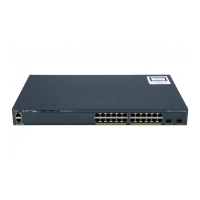13-13
Catalyst 2960 and 2960-S Switches Software Configuration Guide, Release 15.0(1)SE
OL-26520-01
Chapter 13 Configuring VLANs
Displaying VLANs
To delete an extended-range VLAN, use the no vlan vlan-id global configuration command.
The procedure for assigning static-access ports to an extended-range VLAN is the same as for
normal-range VLANs. See the “Assigning Static-Access Ports to a VLAN” section on page 13-10.
This example shows how to create a new extended-range VLAN with all default characteristics, enter
VLAN configuration mode, and save the new VLAN in the switch startup configuration file:
Switch(config)# vtp mode transparent
Switch(config)# vlan 2000
Switch(config-vlan)# end
Switch# copy running-config startup config
Displaying VLANs
Use the show vlan privileged EXEC command to display a list of all VLANs on the switch, including
extended-range VLANs. The display includes VLAN status, ports, and configuration information.
Table 13-3 lists the privileged EXEC commands for monitoring VLANs.
For more details about the show command options and explanations of output fields, see the command
reference for this release.
Configuring VLAN Trunks
These sections contain this conceptual information:
• Trunking Overview, page 13-14
• Default Layer 2 Ethernet Interface VLAN Configuration, page 13-15
• Configuring an Ethernet Interface as a Trunk Port, page 13-15
• Configuring Trunk Ports for Load Sharing, page 13-20
Step 7
show vlan id vlan-id Verify that the VLAN has been created.
Step 8
copy running-config startup config Save your entries in the switch startup configuration file. To save
extended-range VLAN configurations, you need to save the VTP
transparent mode configuration and the extended-range VLAN
configuration in the switch startup configuration file. Otherwise, if the
switch resets, it will default to VTP server mode, and the extended-range
VLAN IDs will not be saved.
Note With VTP version 3, the VLAN configuration is also saved in the
VLAN database.
Command Purpose
Table 13-3 VLAN Monitoring Commands
Command Purpose
show interfaces [vlan
vlan-id]
Display characteristics for all interfaces or for the specified VLAN configured on the switch.
show vlan [id vlan-id] Display parameters for all VLANs or the specified VLAN on the switch.

